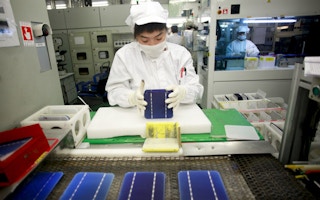Tucked away in this former tin-mining town, past the small farms of banana trees and oil palms, is one of the solar industry’s best-kept secrets.
The six factories here with cavernous rooms up to one-third of a mile long constitute the production backbone of First Solar. Working alongside minivan-size robots adapted from car assembly plants and other industries, 3,700 employees produce five-sixths of the American company’s solar panels. Workers in Ohio make the rest.
The list of manufacturers is long. Panasonic of Japan has a solar panel factory a mile down the road. SunEdison makes wafers 60 miles away in Chemor. Hanwha Q Cells and SunPower have giant factories even farther south, while Solexel, a Silicon Valley start-up, is preparing to build an $810 million solar panel factory in stages.
Malaysia, a Southeast Asian nation with just 30 million people, is the biggest winner in the trade wars that have embroiled the solar sector. As Chinese companies have been hit with American tariffs and European quotas, Malaysia has increasingly attracted multinationals with its relatively low labor costs, lucrative tax breaks, warm relations with the West and abundance of English-speaking engineering talent.
Malaysia is now the world’s third-largest producer of solar equipment, trailing China by a wide margin but catching up rapidly with the European Union. And Malaysia’s role in the global solar trade is only likely to increase in the coming months if the American government broadens tariffs on panels made in China next Tuesday as expected.
“We liked Malaysia because it was a cross between just a straight low-cost play and a high-engineering play — it was sort of in the middle, where it was lower-cost but good engineering,” said Tom Werner, the chief executive of the California-based SunPower, which manufactures half its solar panels in Malacca, Malaysia.
The solar manufacturing boom in Malaysia has been almost invisible, a rarity in an industry known for heavily promoting even the smallest factory opening or new solar panel farm as progress toward cleaner energy.
Manufacturers don’t want to draw attention to moving production offshore. The factories here are almost entirely owned by American, European, South Korean and Japanese companies that much prefer to talk about operations in their home countries.
Hanwha Q Cells, for example, produces 1,100 megawatts a year worth of panels in Malaysia and just 200 megawatts in its home market in Germany. But the company highlights that the engineering work is still done at its headquarters in Thalheim, Germany.
Production in Malaysia “gives us the flexibility to reliably address very different and dynamic international market needs with high-quality products ‘Engineered in Germany,’ ” said Jochen Endle, a company spokesman.
It is a common theme. The technology comes from overseas, but the employees and most of the materials are Malaysian.
Except for two expatriates in the finance department, all of First Solar’s 3,700 employees on three shifts are local hires. A few materials are imported from the United States, like certain electrical cables. But most others are now bought from Malaysian suppliers, like cord plates.
To continue reading the rest of the story, please click here.










